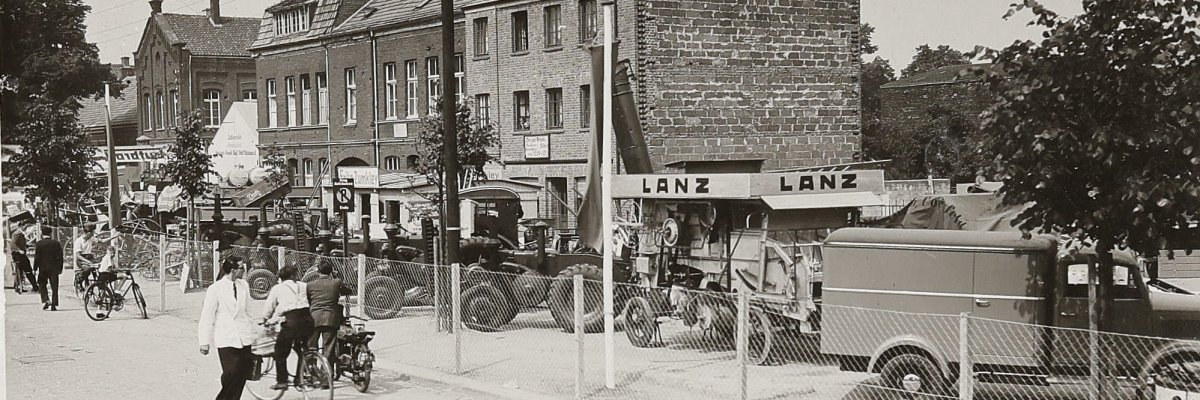City history
The area of today's town of Kevelaer was created on July 1, 1969 by merging the former mayoralty of Kevelaer with the former municipalities of Kevelaer, Twisteden, Wetten and Kleinkevelaer and the mayoralty of Kervenheim with the municipalities of Kervenheim, Winnekendonk and Kervendonk. Today, around 29,000 inhabitants live in Kevelaer on a total of 1,946 hectares. Since July 1, 1993, the town's zip code has been 47623 (previously: 4178).
History
The history of Kevelaer and its districts goes back a long way, with excavations revealing the first traces of settlement around 800 BC at the latest. The first mention of Kevelaer by name dates back to 1300 in a deed of sale of a farm.
Kevelaer, an independent parish since 1472, had been part of the Duchy of Geldern since the Middle Ages, while Kervenheim belonged to the Duchy of Cleves during the Middle Ages and the early modern period. Both villages and the other associated communities were rural and sparsely populated at the time. In the 14th and 15th centuries, the region was repeatedly shaken by inheritance disputes and wars between the ruling dynasties, until Kevelaer fell to the Habsburg dynasty in 1543 after the end of Gelderland's independence and became part of the Spanish crown in 1558 as part of Obergeldern.
17th and 18th century
In the following decades, the town was once again ravaged by wars, including when a group of Croatian mercenaries plundered the town on August 1, 1635 during the Thirty Years' War and killed around 100 inhabitants. Six years later, Hendrick Busman from Kevelaer heard a voice at Christmas in Kevelaer ordering him to build a chapel. First a wayside shrine and then a chapel were erected around an image of grace from Luxembourg. After an official episcopal investigation, this became the center of the Kevelaer pilgrimage, which has shaped the cityscape ever since.
Nevertheless, the town was not spared further plundering during various wars under Spanish rule. This happened once again during the War of the Spanish Succession, which ended in 1713, whereupon Kevelaer came under Prussian rule, as Kervenheim had already done at the beginning of the 17th century. This remained, briefly interrupted by the revolutionary wars and Napoleonic rule from 1795 to 1815, until 1945 and, after the dissolution of Prussia, led to Kevelaer's current affiliation with North Rhine-Westphalia.
19th to 21st century
During the 19th century, the rift that separated Kevelaer from its Dutch neighbors to the west deepened: Where people had once spoken the same dialect and belonged together to the Duchy of Geldern, from 1815 onwards there was an increasing political and linguistic divide between the Netherlands and Prussia - although the Käwels Platt has not completely disappeared to this day. However, Kevelaer found a new connection to the world with the establishment of the still existing railroad line to Kleve and Düsseldorf in 1863.
As part of Prussia, Kevelaer also played a part in the major developments in German history in the 19th and 20th centuries, particularly since the foundation of the German Empire in 1871. Kevelaer citizens fought and died in two world wars and voted in the German Empire, the Weimar Republic and, since 1949, the Federal Republic of Germany. Traditionally, political Catholicism was dominant in Kevelaer for a long time, but National Socialism also gained a foothold here in the 1930s and 1940s. Persecution of Jews has not been recorded, but this is probably because there was no Jewish community in Kevelaer before the war. In any case, Kevelaer paid the price during the World War with destruction caused by bombing raids.
After the war, reconstruction took place and Catholicism regained strength. The pilgrimage had survived the last centuries, albeit with forced breaks at times due to various reprisals. In 1913, 600,000 pilgrims were counted; now, after the Second World War, these figures have risen to over 800,000 pilgrims a year. A highlight of the city's history is the visit of Pope John Paul II in 1987.
The Kevelaer urban area was created in its current form in 1969 by merging Kervenheim and Kevelaer. Since then, a lot has also happened away from the pilgrimage: the built-up area has grown significantly, the population has increased to more than 29,000 and various construction projects have been initiated, including the establishment of numerous schools, commercial enterprises and new administrative buildings, as well as the construction of the indoor swimming pool and, more recently, the brine garden with the graduation house and the inhalatorium. The latest major project is the redesign of Peter-Plümpe-Platz from 2023.

